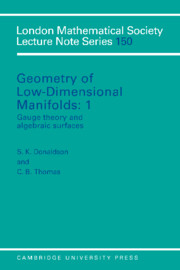Book contents
- Frontmatter
- Contents
- Contributors
- Names of Participants
- Introduction
- Acknowledgments
- PART 1 FOUR-MANIFOLDS AND ALGEBRAIC SURFACES
- 1 Yang-Mills invariants of four-manifolds
- 2 On the topology of algebraic surfaces
- 3 The topology of algebraic surfaces with q = Pg = 0
- 4 On the homeomorphism classification of smooth knotted surfaces in the 4-sphere
- 5 Flat algebraic manifolds
- PART 2 FLOER'S INSTANTON HOMOLOGY GROUPS
- PART 3 DIFFERENTIAL GEOMETRY AND MATHEMATICAL PHYSICS
3 - The topology of algebraic surfaces with q = Pg = 0
Published online by Cambridge University Press: 16 February 2010
- Frontmatter
- Contents
- Contributors
- Names of Participants
- Introduction
- Acknowledgments
- PART 1 FOUR-MANIFOLDS AND ALGEBRAIC SURFACES
- 1 Yang-Mills invariants of four-manifolds
- 2 On the topology of algebraic surfaces
- 3 The topology of algebraic surfaces with q = Pg = 0
- 4 On the homeomorphism classification of smooth knotted surfaces in the 4-sphere
- 5 Flat algebraic manifolds
- PART 2 FLOER'S INSTANTON HOMOLOGY GROUPS
- PART 3 DIFFERENTIAL GEOMETRY AND MATHEMATICAL PHYSICS
Summary
Interest in algebraic surfaces with pg = h0(O(K)) = 0 goes back to the work of Enriques and Castelnuovo in the 19th Century. After Clebsch had proved that curves with pg = 0 are rational, these authors considered the analogous question for surfaces. It was clear to them that in this case the irregularity q = h1(O(K)) has to be controlled as well.
In 1894 Enriques constructed his now famous surface, which is irrational with q= pg = 0? disproving the most obvious rationality criterion. Two years later Castelnuovo proved that the modified conditions q = P2 = p2 = 0 do imply rationality. Thus he substituted the second plurigenus from pk = h0(O(Kk)) for the first. (For the Enriques surface K is a 2-torsion bundle, so the bigenus is one.)
Over the next forty years more examples of irrational surfaces with q = pg = 0 were constructed. Like the Enriques surface they were all elliptic. Only in 1931 did Godeaux [G] find a surface of general type with these invariants. His construction was disarmingly simple: divide the Fermat quintic in CP3 by the standard free Z5- action on the coordinates. Campedelli also gave an example of a surface of general type, introducing his “double plane” construction. This has H1(X, Z) = Z32.
- Type
- Chapter
- Information
- Geometry of Low-Dimensional Manifolds , pp. 55 - 62Publisher: Cambridge University PressPrint publication year: 1991



